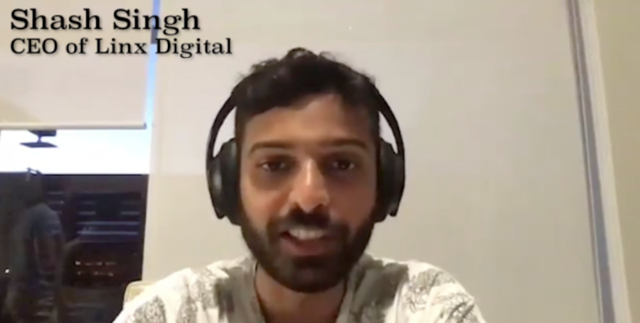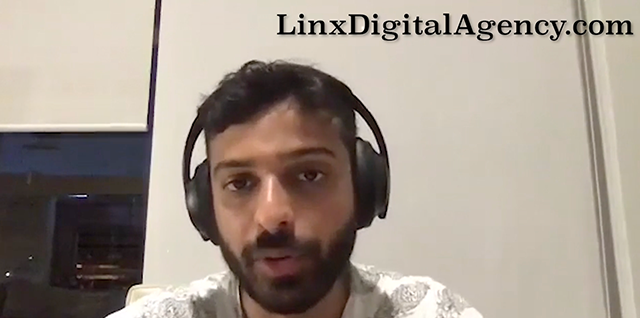Please note: This video’s playtime is 20:13. We recommend this video for the expert insight it contains but in case you don’t have time for the full video we have put together a highlights reel that is under ten minutes in length at the bottom of this page. Go here to watch.
 Membership TodaySign Up Now
Membership TodaySign Up NowVideo Transcript:
E-Commerce and YouTube
Justin Sardi: Hey. What is up, everybody? Justin Sardi, Co-founder and CEO of TubeSift here. And today we’re doing another one of our expert interviews. And we brought my buddy Shash on the call, and he’s going to be talking all about some e-commerce stuff. Now he is with the Linx Digital Agency, but I’ll let him get into that in a little bit here. But thanks for joining us today, man.

Shashwat Singh: Yeah. Glad to be on here. You’re one of the OGs in this space. So, always glad to chat with you and be on here.
Justin Sardi: For sure. So, if you want to just start by doing a quick intro to yourself, telling us a little bit about you, your agency, and even just how you got started doing YouTube ads. And then we’ll dive in.
How the CEO of Linx Digital got Started with YouTube
Shashwat Singh: Awesome. So, basically I got started with YouTube ads around six years ago, when a friend of mine actually reached out to me, and he basically asked me to help run his YouTube ads. I was already doing some SEO stuff for him, that’s what I used to do. And this friend, his name was Greg O’Gallagher, is basically a big fitness influencer, and the ads worked super well, scaled them to have 5k a day spend. They’re making 10 to 15 grand a day in revenue. So, it was a very good first experience. And honestly, I was just lucky. Because I had a really great offer, really great ads, I was just lucky ads manager, and I didn’t even know YouTube ads, it was literally my first time ever running paid ads.
So I was very right place, right time. And then I got into it, started doing it for other clients, found out that, “Okay, it’s not that easy in all situations.” And yeah, now we’re running an agency, work with a lot of e-commerce and info product clients. And actually one of the things I wanted to talk about today, because I think it’s not talked about enough is, YouTube ads for e-commerce, because people ask questions about that. And there’s not really great knowledge out there, there’s not really high level information out there on that.
Cracking the E-Commerce Code with YouTube Ads
Justin Sardi: Yeah, man. I’ve noticed that a lot. Everybody always asks about e-com. It’s a huge thing in the online space. So it makes sense. And most people are just used to the whole Facebook thing where they can toss up a quick 15 second video, whatever it may be, and they hope that’ll work for YouTube. That’s just not the case, completely different platforms. And I feel like a lot of people haven’t really cracked the e-com code even. So super stoked to hear what you’ve been doing in that space, and get some pointers from you over there.
Shashwat Singh: Yeah, for sure. So, I think the first thing that’s really important to talk about is what kind of brand would do well? What kind of product, brand, et cetera. So when I look at e-commerce on YouTube, there’s a few big differences from Facebook. Number one is, you need higher acceptable cost per acquisition. Cost per acquisition off like $10 may sometimes work on Facebook. But if on YouTube, what we’ve generally is that you want to be able to pay at the very low end $30 for new customer, really comfortably at least $40 for our customers. So usually if you can afford to pay $40 for a customer or higher, then you’re in a good place. And that’s where low ticket e-com isn’t my favorite thing with YouTube. I like the products that are a bit more expensive or if they are lower ticket on the front end, they have some sort of backend where you don’t really care too much about the forefront and profitability.

2020 is the Year of the E-Commerce Boom
And this just comes down to the fact that while YouTube is an amazing platform for scale, it’s not that amazing for very low ticket stuff. It’s really good for higher ticket products and for really scaling them up to higher expense. So for example, I think the highest fee scale on e-com is 25K a day in revenue, which was funny enough during COVID times. This is the year of the e-commerce boom. So there’s just a huge volume and you can just go up in volume as long as you have the right kind of product and fit. So the first thing is a $40 acceptable cost per purchase. So you should be able to spend $40 to acquire a new customer and still make those numbers work for your brand. You could get away with lower if you have really high conversion rates, but it’s just one of those things where if we’re taking on a client, we want them to be over that, otherwise there’s a lower chance of success.
The second thing is you need a high conversion rate on your store. So every click you get at least 3% should convert into a customer. 2% is possibly doable if it’s a bunch higher price product, but typically 3% is a good conversion rate that we see for really optimized stores. It is possible to get lower conversion rates and still be profitable if the product is priced the right way. So the end gist of it is if you’re trying to basically make 30 cent clicks work in the US market on YouTube, it’s probably not going to work out. You do need a higher press product and be able to have converting store. And once you have those pieces you have a moat because a lot of these smaller drop shippers that are just starting out, selling $10 gadgets or jewelry.
Many E-Commerce Brands Undervalue Video Advertising
They’re not going to be able to compete for the same traffic. So you’re essentially able to scale much faster because of that moat. And then the second part of it’s obviously the creative. So what we found with YouTube and e-commerce is the creative has something that you need to put a lot of effort into. It’s 80% of it. So a big issue I see is that a lot of e-commerce brands undervalue video. Usually if you’re at the seven figure mark or the eight figure mark, you should be okay with investing in some sort of video ads. Because number one, obviously you can use them for YouTube, number two, you can use them on Facebook. We found consistently that the video ads we create for our clients outperformed their Facebook image ads.
It’s even for info products. A lot of our scripts we create for our clients, they do better, then our clients use them for their Facebook advertising. And number three, you can use video for your brand assets for your Instagram, for your website. One of our clients actually, they put one of the video that we produced for them on their homepage, as a homepage video. So that’s a big part. You have to be comfortable with quality video.
You can’t really get away with super low quality stuff on YouTube. People on YouTube, they’re watching high quality video. They’re watching really interesting v blogs. It’s a much more video oriented platform as opposed to Facebook where you’re scrolling through the newsfeed. So if you see an image ad, or if you see a slideshow video, it’s still going to engage you because you’re competing with texts. But on YouTube, you’re competing with people who [inaudible 00:06:59] stuff with video, you’re competing with YouTubers, whose job it is to literally make the visual version of crack, cocaine for your viewing pleasure.
Grabbing Attention with High Quality Videos
So you have to grab their attention with a well produced video. You can get away with lower quality stuff like voiceover videos as a testing mechanism. You can get away with taking raw footage together, editing it together, maybe adding some simple stuff as a testing mechanism, but we found the key to really scaling on YouTube is really creating a video that number one, is a live action video that shows the product because you’re talking about a physical product. So they’re talking about something where people automatically associate basically the quality of the video, but the quality of the product. When it’s the same thing, let’s say you’re walking down the main street in your city and you see a really nice patio, really nice restaurant. And then you see some ramshackle, really low budget place. If you have the budget for it, you’re going to go for the place that looks nicer.
Same thing is with products. If you have the option between choosing a product that has a video for it, that just looks super professional, you’re going to go for that. The higher quality video also will display the better characteristics. And then you have to script it right. You have to make sure the formula and so on is set up properly and you have to have strong call to actions. So, a very strong call to action is a key where you actually tell them in the video, “Hey, go click on this website to get this product.” Now, I don’t want to go for hours about this because obviously we want to keep this timely, but with the videos it’s important where, if you’ve got a brand that’s doing seven figures or eight figures, you should be okay with, at the minimum testing with a budget of $4000 to $5,000 on the videos themselves.
So 4 to 5K you can some decent videos made for that budget. And then if something starts working well, then you should be okay with spending more, just because it’s such a huge brand asset. And quite honestly, there’ve been a lot of e-com companies that have done extremely well with YouTube, but every single one of them, dollar beard club, Poo-Pourri, these all got videos done by guys like the Harmon Brothers. I think one of the latest ones I’ve seen is for a skincare brand, a men’s skincare and then a sunglasses brand. I forget their name. It was-
Justin Sardi: William Painter was the guy who did [crosstalk 00:09:27] sunglasses one. I was actually working with the client in the fitness space and they modeled that type of ad where he’s walking through and doing all that. That ad is killing it. It’s doing amazing things. Because it’s very engaging story. People want to watch that kind of stuff.
Shashwat Singh: Mm-hmm (affirmative) Yeah. And the William Painter ad, for example, I’m pretty sure they did it in-house in the sense that they had a video team. But if you look at the production value, it’s done really well. And then people are coming in with really low quality videos that they got from their drop shipping supplier. And it’s just not going to work the same way. It may work to some level of success and I’ve seen videos like that actually do well.
But they’re the exception to the rule. When I see the videos that do really well, it’s usually the ones that had a lot of effort put into them. It’s a video platform. So it’s pretty important to just be okay with the understanding that a big part of your spend is going to be video. So usually the way I think about it is a certain percentage of your… Let’s say you get your ad program on YouTube started, you should be investing a certain percentage of your profits back into more videos.
The Importance of Testing Multiple Video Hooks
Justin Sardi: Right. Right. Testing’s so important, even if it’s just swapping out the first, the hook part of the video. That can make a huge difference. I’ve seen a lot of people running ads with multiple hooks in the beginning with the rest being the same and just that slight tweak in the beginning has made all the difference as well. So just different variations.
Shashwat Singh: Yeah. And it’s actually crazy. I think for one of our clients Indestructible Shoes, they had I think just one hook and one variation. We cut up like six different ones. One of them just did better than the rest and we ended up spending hundreds of thousands on that fun app. So it’s kind of crazy. You have to definitely reset level where you have a video that grabs people’s attention. But at that point, then you want to test it. You want to have different edits, different variations, try a longer version, shorter version. And then that’s kind of the key of it. You want to have both quality and quantity. And the cool thing about doing those quick video edits, it literally does not cost you much more because all you need is a video editor to go in and make those changes. And you actually shoot the video on the [inaudible 00:11:53]. You shoot different hooks and then you have a different body and then if you want, you can even have different calls to actions and so on.
Do Unboxing Videos for Product Demonstrations Convert?
Justin Sardi: Nice. Nice. So real quick question for you. I’m sure you may have seen that… what was it… it was like Lit Mobile or something like that. They ran tens of millions of views through a few different variations, just because I was following them. I saw their ads everywhere. It was a little cell phone bank charger. It was actually a pretty… I don’t want to call it a low quality video, but it was basically this dude’s hands. And he was basically doing an unboxing video. He’s like, “Hey, this company just sent me this product. Let’s see what it’s all about.” And opens it. And he’s literally just running through the features of this thing. Just out of curiosity, have you seen those kinds of unboxing videos working or have you ever tested any of those things?
Shashwat Singh: So we we’ve tested a couple of unboxing videos. The thing is the ones we tested they’re from influencers. So they weren’t like tightly scripted. We actually are about to test unboxing videos right now that are scripted from scratch. Because the problem is if you take videos that are already preexisting from an influencer, it’s not really scripted to convert. So those didn’t perform amazingly well, but we do have unboxing footage in some of our ads.
Justin Sardi: Okay. I was just curious on that just because I saw those ads everywhere and I was actually just talking on one of our other blog posts about how to make a video without being on camera. And that was one of the examples I used. And when I had originally checked it at maybe like 100,000 views, last time I checked, it had 27 million on one of them. I was like, “Whoa, this must be working.”
Shashwat Singh: That’s a really great idea. Yeah, I like that. Unboxing’s definitely on the list of stuff that you want to test. And it’s easy, because you can literally hire somebody to do it for a couple of hundred bucks. So it’s like one of those low effort, high ROI things that you can do. And that’s the cool thing with the video ads as well. You don’t necessarily need to test the huge budget. You can do things where you take a voiceover artist, you take the raw footage of your product, maybe even unboxing footage and you combine them. So we’ve actually had really good success with voiceover footage combined with product footage, because then the voice actually tells them exactly what’s going on and takes them through the product while obviously the footage demonstrates the product. But the best results we’ve seen has always been with somebody’s on camera actually showing them. But obviously you don’t need to start with that, but that’s where you want to end up.
Justin Sardi: That makes sense because that’s the kind of videos people are used to watching on YouTube. You’re trying to match what people are used to on that platform. So, everything you said totally makes sense there. So one other question I have for you. What’s your typical process you go about targeting these types of… how do you target your ideal audience? Are you using in-market audiences? What do you start with, I guess?
YouTube Targeting for E-Commerce
Shashwat Singh: So starting the, usually a mix of keywords, custom audiences. So based on URLs or based on basically Google search terms. Obviously placements is something you can do. And in-market for sure. And then as we start scaling we start really trying everything. What we’ve discovered is different accounts will do well with different things. So sometimes we’ve in-market work really well, especially in the e-com in-market has worked really well. Sometimes we’ve had no targeting work well, literally no targeting-
Justin Sardi: Straight up [crosstalk 00:15:44].
Shashwat Singh: … just demographics. Once an account hits a certain point where it has a ton of data, we will start running no targeting. And at that point that actually can work. And it’s actually been some of our biggest campaigns where we spent $3000 or $4,000 a day on e-commerce stuff just on no targeting. And right now we have a campaign for an info product that we were running and we’re spending $1500 a day on literally no targeting.
Justin Sardi: You’re using campaign goals and having Google Optimize for specific conversion actions when you’re doing that?
Shashwat Singh: Yeah, usually it’s target CPA. But for this info product, it’s maximized conversions. So we use target CPA and maximize conversions a lot. And sometimes for some weird reason, maximize conversions, even though in most accounts it doesn’t work better, in some accounts it works better. In this particular account, every time we’ve tried to use target CPA for our biggest campaigns, results have gone down while in other accounts target CPA just consistently outperforms maximize conversions. So much of this is dependent on the product, the price point of the product, the conversions you’re optimizing for. For example, if I was optimizing for, let’s say a $6,000 sale. Let’s say, a super high ticket info product. No targeting even if it gets cheap leads, it may not get you the best leads. On the other hand for e-com, you know pretty fast if it’s getting you sales or not.
Test your Advertising Often
You know a couple of 100 bucks in spend it’s working or it’s not working. On the other hand for $6,000 product, to really test that you’d have to spend like $5,000 plus or something. So yeah, it’s one of those things where it depends on the context, but the key thing is you have to test a lot. I know this sounds obvious, but do you have to test a lot and you want to start with the more narrow audience’s posts. So keywords, placements, maybe some in-market ROI, custom audiences. And then you start expanding to affinity topic audiences, you’ve eventually trying no targeting at all, that’s the true scale.
Justin Sardi: Nice. I’m going to have to try that. I’ve been doing some consulting with a buddy of mine and we were optimizing for leads, which is what you were saying a little bit earlier. But then ultimately, their goal is to get somebody on a sales call. So we actually stopped optimizing for leads once we got some data and started optimizing for just getting people on the call and we were able to cut the cost per call in half and the quality is so much better. It’s crazy.

Shashwat Singh: Nice. Nice. Yeah. That’s also something to try. Try optimizing for a higher level event instead of lower level events. So for example, usually with YouTube ads people optimize for leads on sales or for e-com, it will be checkouts, add to carts and purchases. So try both. In some cases we’ve, let’s say, stopped optimizing for leads and tried to optimize for calls and actually backfired on us where it didn’t actually work that well. But in some cases it actually does work better. Usually you just need to have a lot of volume and if you’re just going to optimize for an event that happens less.
Justin Sardi: Nice. Cool man. Well, thanks a bunch for your time. I don’t want to keep you on here too long. I could go on all day, but if people wanted to reach out to you and talk with you about helping get their ads going, all that kind of stuff, let us know where.
Shashwat Singh: Yeah. So a couple of places, linxdigitalagency.com. So I guess we’ll put a link in there or something. And then I got a YouTube channel as well, where you can watch videos and learn for free. And then you can also hit me up on my personal profile if you need anything.
Justin Sardi: Cool. Cool. And we’ll drop links below this video for all that. Thanks a bunch for taking some time out, shedding some light on that. I know a lot of people don’t talk about e-com. So I’m really excited to get this out to all our people.
Shashwat Singh: Awesome. No worries. Ta-da. Cheers.
Justin Sardi: Later.
TL;DW
 Membership TodaySign Up Now
Membership TodaySign Up NowResources
- Linx Digital Agency helps E-Commerce and Info Product Businesses Scale to 8 Figures
- Shash Singh – Linx Digital University YouTube Channel
- How to Find Monetized Placements for YouTube Ads
- How Many YouTube Ad Placements do I need?
- Targeting via Google Search Terms
- Scaling YouTube Ads with Brian Moncada
- The Power of YouTube Advertising with Michael Szapkiw
- Target CPA: What it is, Why it is Important



Comments are closed.